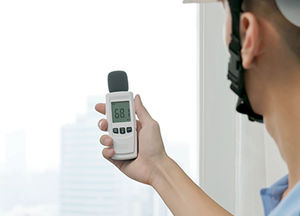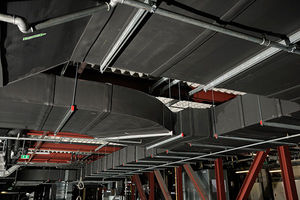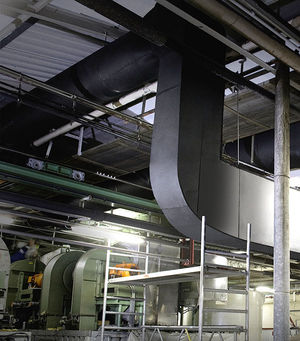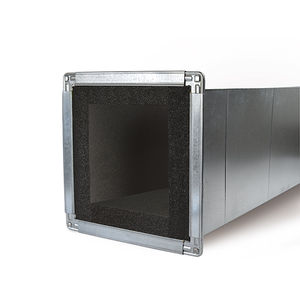 A growing megatrend in the construction and building materials industry is noise control and acoustical comfort. Increased population, rapid urbanization, transportation growth, and the booming housing market have all created elevated acoustical concerns. Armacell can create sustainable value and minimize the effect of environmental noise issues with innovative thermal and acoustic solutions, ultimately improving the health and comfort of spaces.
A growing megatrend in the construction and building materials industry is noise control and acoustical comfort. Increased population, rapid urbanization, transportation growth, and the booming housing market have all created elevated acoustical concerns. Armacell can create sustainable value and minimize the effect of environmental noise issues with innovative thermal and acoustic solutions, ultimately improving the health and comfort of spaces.
Double-Duty: Thermal and Acoustic Insulation
The acoustic properties of foam help mitigate both structure-borne and airborne noise, improving indoor environmental quality (IEQ) in all types of occupied spaces. All of the AP/ArmaFlex® closed-cell foam and AP/CoilFlex® conformable foam insulation products offer acoustical performance along with the thermal efficiency and energy savings they provide. Whether used in HVAC systems to quiet low-frequency sound or to damp vibrations Armacell foam insulation makes a real difference in any environment. In plumbing systems, ArmaFlex foam quiets the sounds of rushing fluids in piping.
Types of Noise Associated with Ducts
 Let’s talk about sound in terms of two categories: structure-borne sound and airborne sound. The latter, airborne sound, is the noise we actually hear. It can and will travel anywhere there is air. Structure-borne sound results from a physical vibration of materials caused by some impact event or other form of mechanical excitation that causes vibration.
Let’s talk about sound in terms of two categories: structure-borne sound and airborne sound. The latter, airborne sound, is the noise we actually hear. It can and will travel anywhere there is air. Structure-borne sound results from a physical vibration of materials caused by some impact event or other form of mechanical excitation that causes vibration.
In most cases, structure-borne sound travels through the building structure via construction materials, frame, and interior elements. It eventually becomes airborne sound that can be heard at some distance from its source, perhaps several floors away. Airborne sound also can become structure-borne, causing surrounding surfaces to vibrate. Consider a sheet-metal duct, a virtual wind tunnel through which any noise can travel. It provides a structural and an airborne path for noise generated by mechanical equipment such as fans and chillers. It also can transmit noise from virtually any other source in the building, including people, speakers, and machines. This airborne-to-structure-borne conversion can repeat multiple times until the sound source is eliminate or mitigated.
Benefits of Elastomeric Foam Insulation
 There are several sources of sound-related complaints in an HVAC system. All of these noises can travel through the air in the duct in the form of sound waves or through the duct panels in the form of mechanical vibration. It is generally well known and accepted by acoustic engineers that the 125-1000 Hz range is typically the most problematic in an HVAC system. This is the range that can and should be addressed with duct liner.
There are several sources of sound-related complaints in an HVAC system. All of these noises can travel through the air in the duct in the form of sound waves or through the duct panels in the form of mechanical vibration. It is generally well known and accepted by acoustic engineers that the 125-1000 Hz range is typically the most problematic in an HVAC system. This is the range that can and should be addressed with duct liner.
Commonly used fiber-based duct liners absorb sound primarily through viscous and frictional losses of the air oscillating inside the material. These materials, in typical 1-inch thicknesses, are effective over a relatively broad range of frequencies, but their sound absorption performances diminish significantly at 500 Hz and below.
 Elastomeric foam products, such as AP/ArmaFlex and AP/CoilFlex, react to sound quite differently. AP/ArmaFlex is a closed-cell fiber free, elastomeric foam with higher density than fibrous duct liner which aids in stabilizing the duct construction to reduce sound transmission via structurally borne sound. The smooth surface of AP/ArmaFlex prevents accumulation of dust and provides a cleanable surface to promote better indoor quality. AP/CoilFlex is a conformable elastomeric foam also with a porous surface to allow sound absorbency. The cell structure of the product allows absorbance of low frequency sounds which are typically present in HVAC systems.
Elastomeric foam products, such as AP/ArmaFlex and AP/CoilFlex, react to sound quite differently. AP/ArmaFlex is a closed-cell fiber free, elastomeric foam with higher density than fibrous duct liner which aids in stabilizing the duct construction to reduce sound transmission via structurally borne sound. The smooth surface of AP/ArmaFlex prevents accumulation of dust and provides a cleanable surface to promote better indoor quality. AP/CoilFlex is a conformable elastomeric foam also with a porous surface to allow sound absorbency. The cell structure of the product allows absorbance of low frequency sounds which are typically present in HVAC systems.
